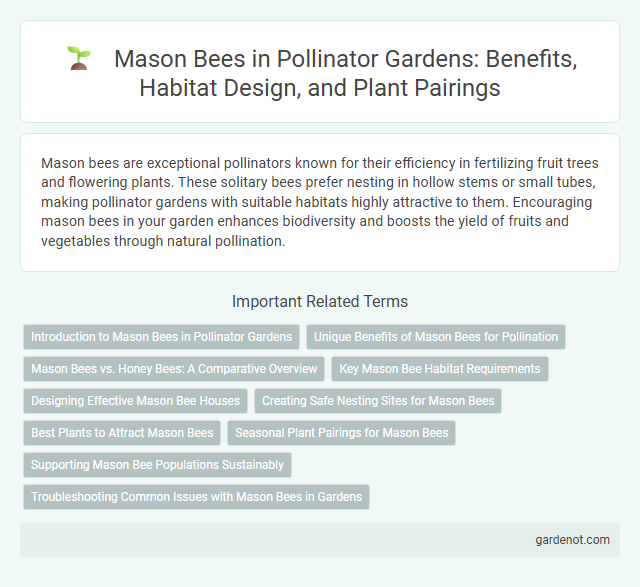Mason bees are exceptional pollinators known for their efficiency in fertilizing fruit trees and flowering plants. These solitary bees prefer nesting in hollow stems or small tubes, making pollinator gardens with suitable habitats highly attractive to them. Encouraging mason bees in your garden enhances biodiversity and boosts the yield of fruits and vegetables through natural pollination.
Introduction to Mason Bees in Pollinator Gardens
Mason bees are solitary, native pollinators known for their exceptional efficiency in fruit and vegetable gardens. Their unique nesting behavior involves burrowing tunnels and sealing brood cells with mud, which supports healthy population growth without requiring hive maintenance. These bees enhance biodiversity and increase crop yields by pollinating early spring blossoms when honeybee activity is low.
Unique Benefits of Mason Bees for Pollination
Mason bees are exceptional pollinators due to their efficient foraging behavior, visiting flowers in cooler temperatures and lower light compared to honeybees. Their ability to pollinate fruit trees such as apples, cherries, and blueberries enhances crop yields and quality significantly. Unlike honeybees, mason bees are solitary and non-aggressive, making them ideal for home gardens and agricultural settings focused on sustainable pollination.
Mason Bees vs. Honey Bees: A Comparative Overview
Mason bees (Osmia spp.) are solitary pollinators known for their efficient early spring pollination, requiring less space and care compared to honey bees (Apis mellifera), which live in large colonies and produce honey. Unlike honey bees, mason bees do not produce honey or wax but are exceptional at pollinating fruit trees and flowering plants due to their specialized foraging behavior and high pollen transfer rates. Mason bees' gentle nature and rapid pollination make them valuable in pollinator gardens, especially where hive maintenance and aggressive stinging behavior of honey bees may be concerns.
Key Mason Bee Habitat Requirements
Mason bees require nesting sites such as hollow stems, wood cavities, or bee houses with 5-8 mm diameter holes for optimal habitat conditions. Access to mud or wet soil is essential as these bees use it to construct partitioning walls within their nests. A diverse array of native flowering plants blooming throughout spring ensures a continuous pollen and nectar supply critical for mason bee foraging and reproduction.
Designing Effective Mason Bee Houses
Designing effective Mason bee houses requires selecting materials such as untreated wood or natural reeds that mimic their natural nesting habitats. Proper placement in a sunny, sheltered location with tubes or holes 5-8 mm in diameter encourages female Mason bees to nest and provision individual cells. Incorporating removable nesting blocks or paper tubes facilitates easy cleaning and reduces parasite buildup, enhancing bee health and pollination efficiency in gardens.
Creating Safe Nesting Sites for Mason Bees
Creating safe nesting sites for Mason bees involves providing hollow tubes, wooden blocks with drilled holes, or bundles of hollow stems in sheltered, pesticide-free areas. Nesting habitats should be placed facing southeast to capture morning sunlight, enhancing bee activity and development. Regular maintenance includes cleaning or replacing nesting materials annually to prevent disease and promote healthy bee populations.
Best Plants to Attract Mason Bees
Mason bees are highly attracted to native flowering plants such as lavender, catmint, and elderberry, which provide abundant nectar and pollen essential for their foraging. Fruit trees like apples and cherries also serve as vital pollen sources during early spring when mason bees are most active. Incorporating a diverse mix of early-blooming perennials and shrubs supports mason bee populations by ensuring continuous food availability throughout their active seasons.
Seasonal Plant Pairings for Mason Bees
Mason bees thrive when paired with early-blooming native plants such as crocus, forsythia, and cherry blossoms that provide essential pollen and nectar during their active spring season. Incorporating a succession of flowering plants like lilac, apple, and wild geranium ensures a continuous food source throughout their lifecycle. These seasonal plant pairings enhance mason bee pollination efficiency and support healthy population growth in pollinator gardens.
Supporting Mason Bee Populations Sustainably
Mason bees are vital pollinators that significantly boost fruit and vegetable yields in pollinator gardens. Providing sustainable habitats such as bee hotels made from natural materials encourages nesting and supports population growth. Planting native, pollen-rich flowers nearby ensures a continuous food source essential for mason bee survival and ecosystem health.
Troubleshooting Common Issues with Mason Bees in Gardens
Mason bees often face challenges such as nest abandonment, parasitic wasps, and moisture-related mold in gardens. Ensuring proper nesting materials, regular monitoring for parasites, and placing nests in sheltered, dry locations significantly improves their survival and pollination efficiency. Using organic pest control methods and maintaining clean nesting tubes helps mitigate these common issues effectively.
Mason bee Infographic

 gardenot.com
gardenot.com